Are you interested in knowing: what is email segmentation? Segmentation in email marketing is a crucial marketing approach that plays a vital role in successful email marketing.
You will be amazed to learn that 73% of customers prefer better personalization. Pretty high, right? In email marketing, the main way to deliver a personalized experience is through email list segmentation. So, you have an idea of how impactful email segmentation is in the marketing field. If you are willing to excel in email marketing, you have to learn and implement email segmentation strategies.
Therefore, in this blog, I will discuss the basics of email segmentation in detail. So join in and keep reading with your full attention. Let’s dive in!
Table of Contents
- What is Email Segmentation?
- Why Email Segmentation is Important?
- 5 Types of Email Segmentation
- Wrap Up
- FAQ on “What is Email Segmentation”
What is Email Segmentation?
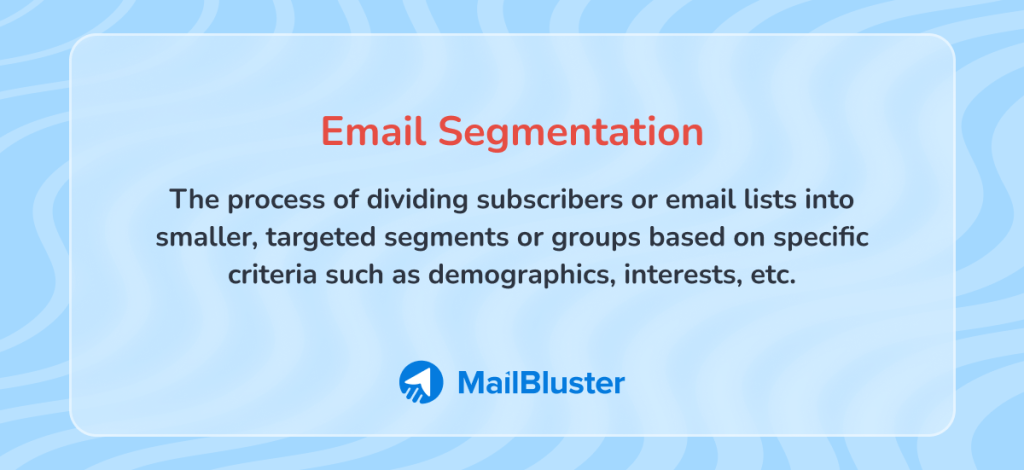
So, what is email segmentation? Email segmentation is the process of dividing subscribers or email lists into smaller, targeted segments or groups based on specific criteria such as demographics, interests, etc. Simply put, email list segmentation is organizing the recipients of email lists into smaller groups. What’s the purpose of email segmentation? The intent behind segmenting the email list is to serve the recipients with relevant experiences. For example, it helps in sending personalized email campaigns.
Explaining the email list segmentation process
Let me explain in a simpler way to better understand: what is email list segmentation? Through this explanation, you will also get ideas on email segmentation strategies as you will understand how the segmentation process works.
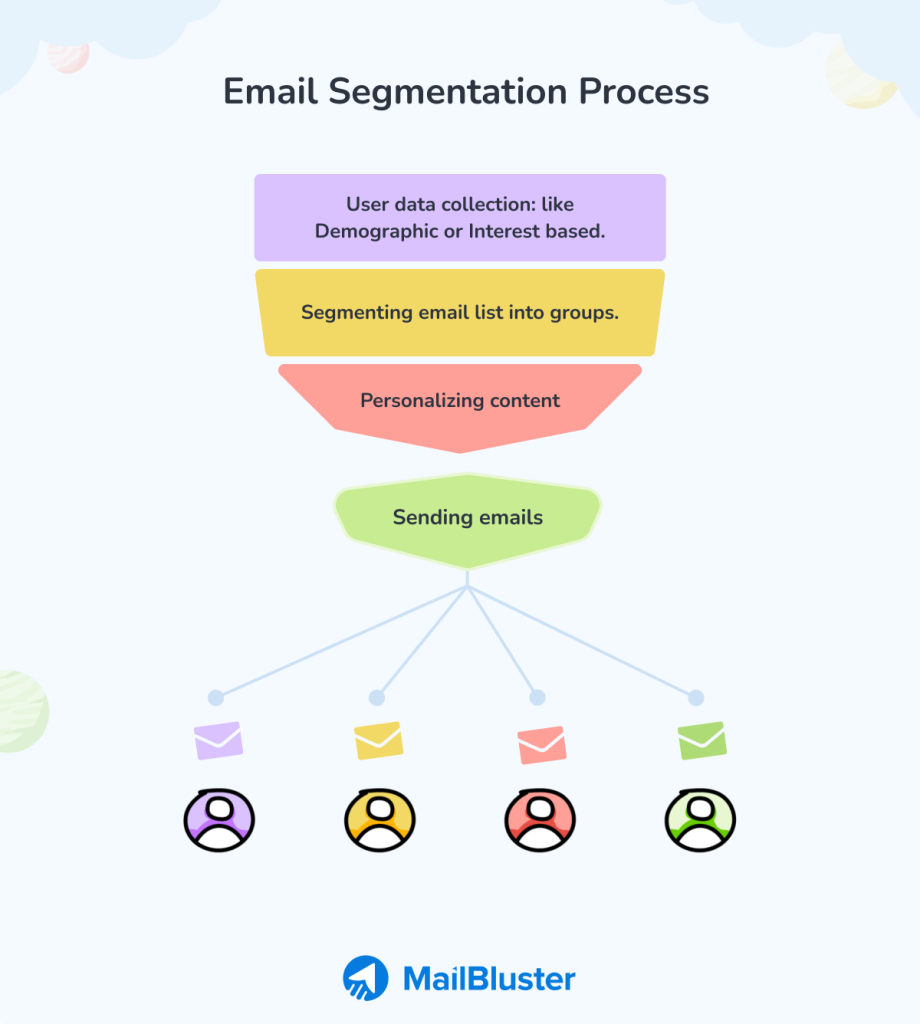
Let’s have an example of it from my scenario. I’m an avid reader, and recently subscribed to an “author newsletter” service. So, after subscribing, what are the possible ways for initial email segmentation? Let’s see!
The possible ways of initial email segmentation are:
- New subscriber
- My gender
- My location: mostly where I live
- My selected interest: selected favorite genres
Now, after being their subscriber for a while, what happens afterwards?
After a certain period of tracking my online activities as a user, and through behavioral targeting, they will simplify the interest-based segment group by targeting my behavior, for instance, genres or types of books I search or read frequently. And even they will further segment based on my purchase or transactional records, such as the number of books that I have bought/read from the said author.
What is the outcome of email segmentation?
The segmentation process will be based on all these aspects, and as a result, I will get a personalized experience. I will receive relevant email content, which will create an urge in me to engage and take required action through email CTAs (Call-to-action). Thus, the segmentation in email marketing helps the brand boost conversion.
Take a look at this summarized infographic:
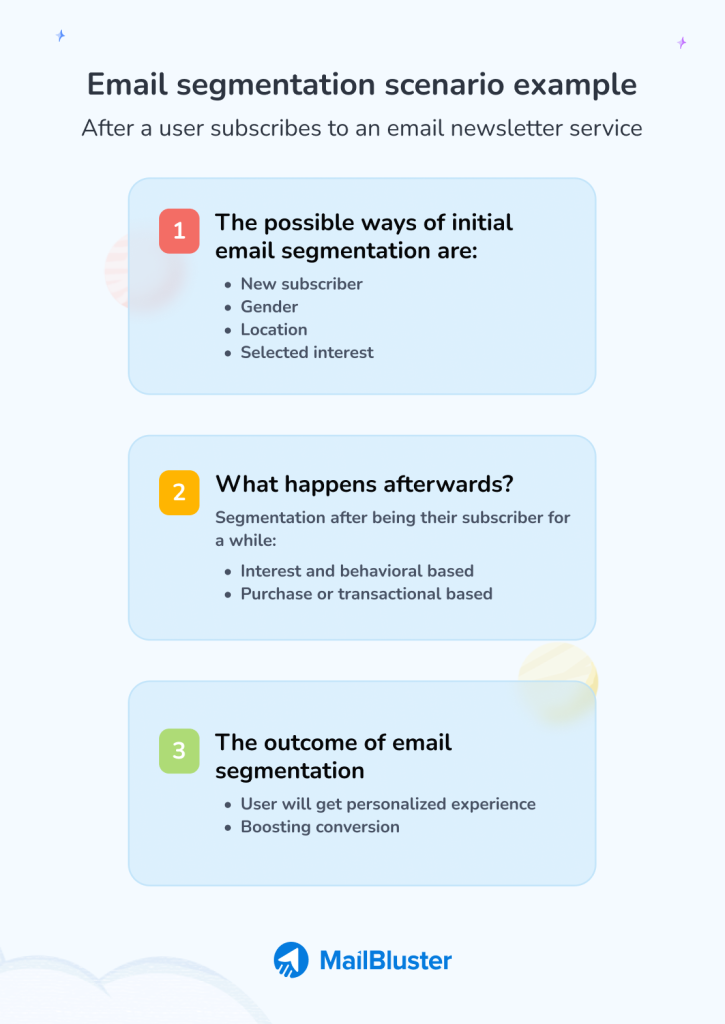
Email segmentation example from a real-life brand email
Let’s look at an email crafted with the email segmentation approach.
The following email newsletter was sent using the behavioral targeting segmentation method. See here, Lululemon is showcasing its popular products titled “future favourites.” They organized the email template based on the user’s preferences and purchase records.
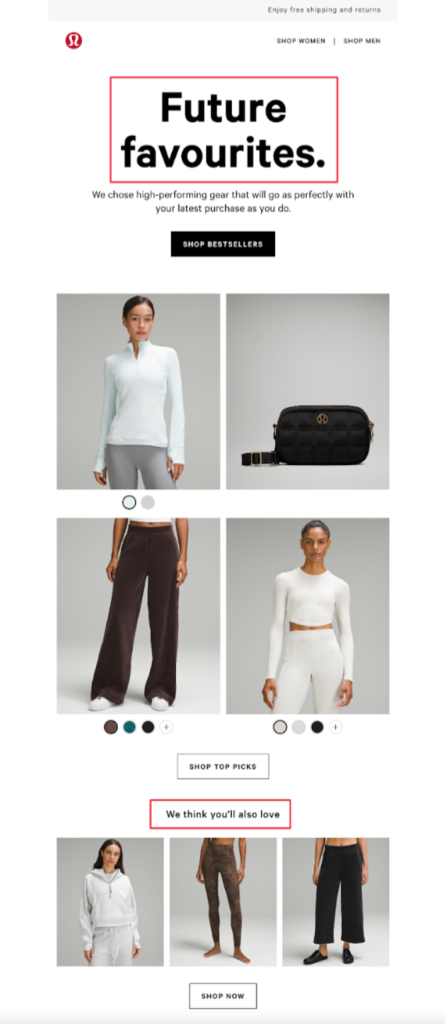
Why Email Segmentation is Important?
The next step in better understanding “what is email segmentation” is to learning why email segmentation is important. You have to know the benefits of email segmentation to realize its vital importance. So, let’s understand its key benefits, and you will see all these benefits are connected in coming up with the best outcomes.
Take a glance at the 6 benefits of email segmentation:
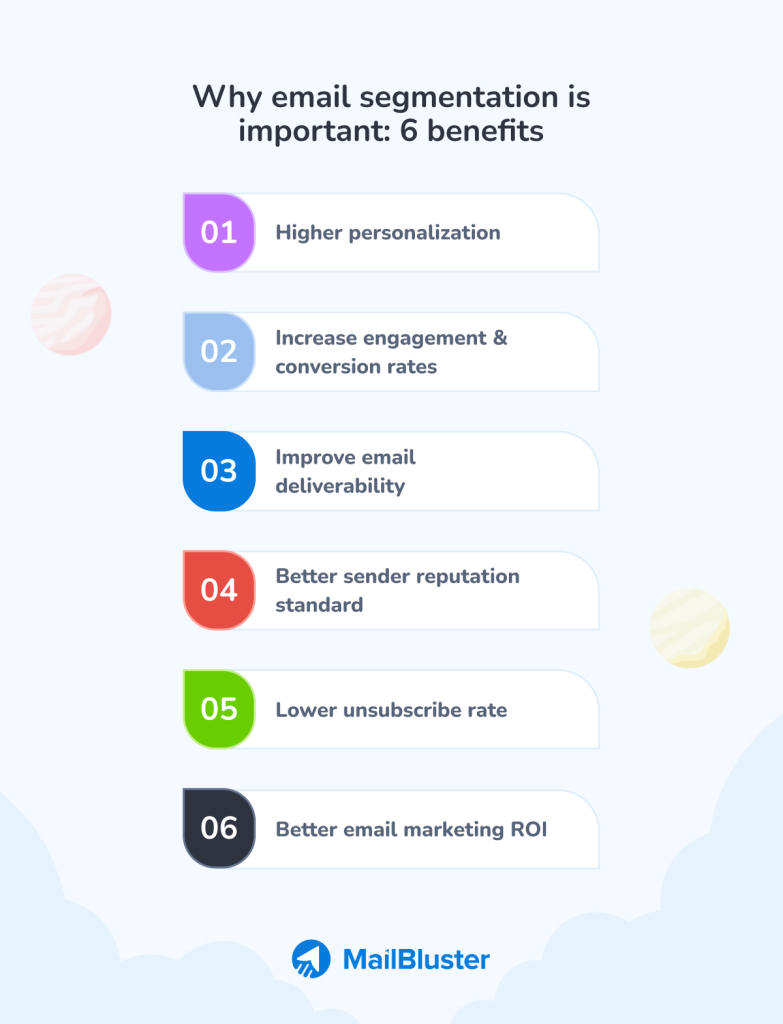
Higher personalization
The very aim of email segmentation is to provide a personalized experience to audiences so that they can relate to the email newsletter content. By now, you already have the idea from the above explained scenario example of email segmentation, of how it is actually done.
It helps increase personalization by dividing subscribers into groups based on various criteria like characteristics, user behavior, interest, etc., then the brands send targeted, highly personalized dynamic emails accordingly to each group. Eventually, this leads to higher personalization.
Increase engagement and conversion rates
Both engagement and conversion rates can be boosted through personalized content. And now you know, email segmentation causes higher personalization. This is a key to getting increased engagement and conversion rates. Audiences engage more with the email content that they find relevant. Plus, the more they find relevant content, the more they will opt for hitting the required CTA buttons, which will lead to increased conversion rates.
Better sender reputation standard
Email segmentation lets you send relevant emails to recipients, helping increase engagement. And a high engagement rate means your brand is on the right track in terms of sending genuine email content rather than bulk spam emails. This raises the “sender reputation” standard, which is essential in building rapport and credibility.
Improve email deliverability
Email segmentation helps you improve email deliverability. How? To achieve a high deliverability rate, the three main needs are personalized email newsletters, a high engagement rate, and a better sender reputation, and you already know that all these benefits come with email segmentation. So, eventually, you will have an improved email deliverability.
The more audiences engage, the more it ensures your brand is authentic and won’t mark you as spammy. All these help in improving and increasing email deliverability.
Lower unsubscribe rate
Email segmentation helps in keeping a healthy, lower unsubscribe rate. Because subscribers feel relevant reading such as personalized newsletters, business emails, or something they can relate to, leads to keeping the recipient contented. And the more you have satisfied recipients, the less likely they are to hit the unsubscribe link in the email. Therefore, eventually, you will get a lower unsubscribe rate. This also benefits in raising the brand value and sender reputation we discussed in the previous section.
Better email marketing ROI
The five benefits of email segmentation listed above will also help you achieve better email marketing ROI (return on investment). According to studies, segmented email marketing campaigns bring in a 760% increase in email revenue over non-segmented ones. Sending personalized emails through email segmentation helps in getting increased conversion rates, just as we have discussed earlier. And increased conversion means higher profit, which means better ROI.
5 Types of Email Segmentation
Now, take another step in further understanding “what is email segmentation.” Let’s learn about the five most essential email segmentation types.
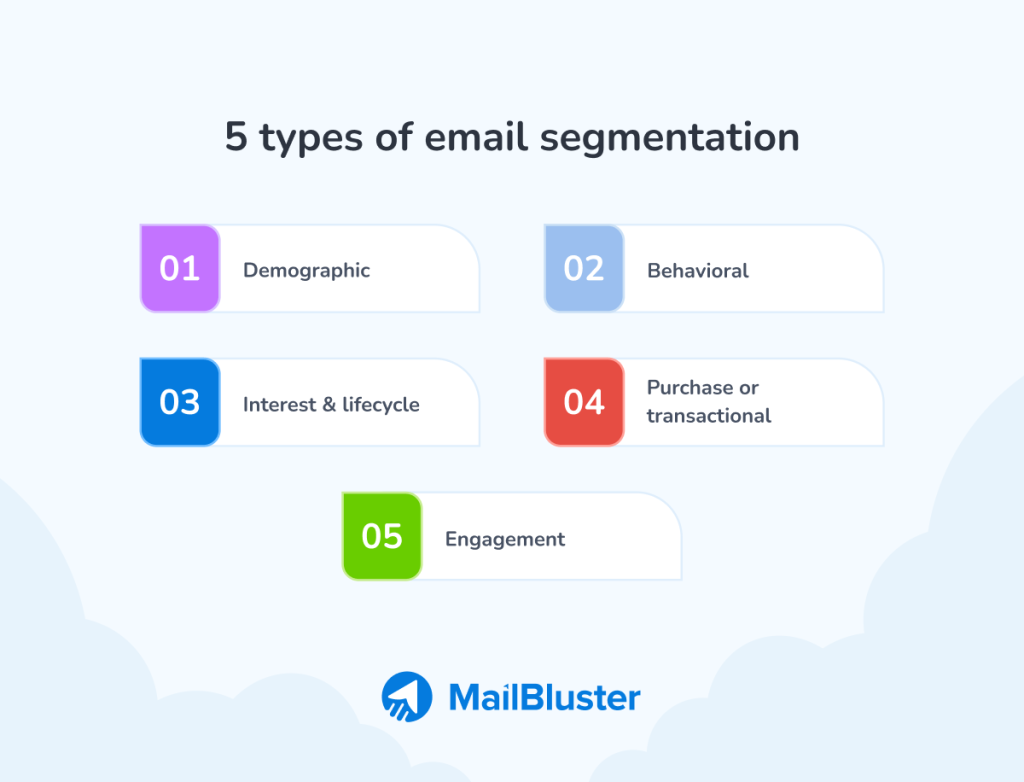
Demographic
Demographic segmentation is a marketing approach that divides an email list into smaller groups based on shared characteristics such as:
- Age
- Gender
- Location
- Ethnicity
- Income
- Education
- Marital status, etc.
It is a simple and cost-effective strategy since the essential information is frequently accessible from public records or market research.
Use case example for demographic segmentation in an email list
For younger consumers, a beauty brand can send emails showcasing fashionable and trendy makeup that is influenced by social media. On the other hand, for more mature customers, they can promote high-performance anti-aging skincare products via segmented personalized emails.
Behavioral
In the behavioral segmentation, customers are divided into groups based on their behavioral actions, such as:
- User activity
- Website activity
- Search queries
- Purchase history
- Product usage
- Brand loyalty
- Engagement with campaigns, etc.
By analyzing these behaviors through the behavioral targeting process, businesses can create more targeted, personalized marketing that improves the customer experience, drives engagement, and increases sales.
Use case example for behavioral segmentation in an email list
If a client has been viewing a certain product frequently but has not yet made a purchase, behavioral segmentation allows you to send that customer an email with a coupon offering a discount on the product.
Interest and lifecycle
Audience interest segmentation is an essential marketing strategy. In this audience interest and lifecycle segmentation, audiences are divided into groups based on their shared interests and their current stage in the email customer journey. This includes:
- Favorite choices
- Hobbies
- Passions
- Values
- Topics users have shown interest in through
- links they’ve clicked
- product categories they have browsed
- and survey responses
- Relationship with the brand;
- new visitors
- customers
- loyal advocates, etc.
This marketing approach concentrates on the specific personalized content and product preferences that audiences have either expressed.
Use case example for interest and lifestyle segmentation in an email list
If you are a content creator, you can send email newsletters based on the interests of the user. For example, users who are into travelling, you can send travel related informational newsletters.
Purchase or transactional
Purchase or transactional segmentation is dividing the email list into smaller groups based on customers’ purchasing behavior or transactional records. This includes:
- Past purchases
- Purchase frequency
- Product categories
- Transaction details
- Spending habits, etc.
This marketing approach lets businesses enhance their client relationships, increase revenue, and develop more targeted marketing email campaigns by gaining a better understanding of their customer base.
Use case example for purchase or transactional segmentation in an email list
A clothing shop owner can send a retention or feedback email to a customer who recently made a purchase, asking for their opinion on the quality of the purchased items.
Engagement
Engagement segmentation is just as the word indicates, which is segmentation by engagement. It’s a marketing strategy that divides email lists into groups based on engagement. Meaning you have to collect engagement data for segmentation criteria. And this includes:
- Customers’ interaction level with a brand
- Highly engaged
- Moderately engaged
- Inactive
- Using metrics such as email opens, clicks, and conversions.
This engagement-based segmentation allows businesses to develop highly personalized business email campaigns. And it helps immensely in enhancing loyalty and conversion rates.
Use case example for engagement segmentation in an email list
Using segmentation by engagement, an e-commerce shop can reward its highly engaged and loyal subscribers with exclusive offers via email. They can also launch re-engagement campaigns with special offers for inactive members, urging them to get back in the fold.
Read for more to learn email segmentation strategy: Email Segmentation Ideas & Strategies
Wrap Up
That was all in learning and understanding: what is email segmentation! This blog has covered all the essential basic parts and discussed in-depth regarding this crucial email marketing approach. Now that you are aware of email segmentation, all you need to do is set your email segmentation strategy and use an effective email marketing tool like MailBluster, which offers an effective email list segmentation feature. Then, you can proceed with implementing the essential segmentation in a smooth and efficient process.
FAQ on “What is Email Segmentation”
Segmentation separates a broad market into smaller divisions based on various essential criteria like demographics, behavior, or psychographics. This is done to create tailored marketing campaigns and to enhance consumer satisfaction and loyalty.
Email segmentation means dividing your subscriber list into smaller groups based on demographics, behavior, or hobbies to create personalized email campaigns. This allows marketers to create content that meets the wants and needs of each segment, rather than using a one-size-fits-all approach.
Geographic segmentation is a marketing approach that splits a larger market into smaller segments based on geographic factors. This includes: Location, time, climate, season, cultural preferences, language, and urbanicity.
1. Start by using an email tool to separate email lists.
2. Collect relevant user data.
3. Segment email lists accordingly.
4. Check, test, and make changes for improvement.
The five stages of market segmentation are: 1) grouping potential buyers into segments; 2) grouping products into categories; 3) developing market-product grid and estimating market sizes; 4) selecting target markets; and 5) taking marketing actions to reach target markets.
Marketers construct their ideal customer profile (ICP) using four pillars of segmentation: 1) demographics; 2) psychographics; 3) geography; and 4) behavioral.


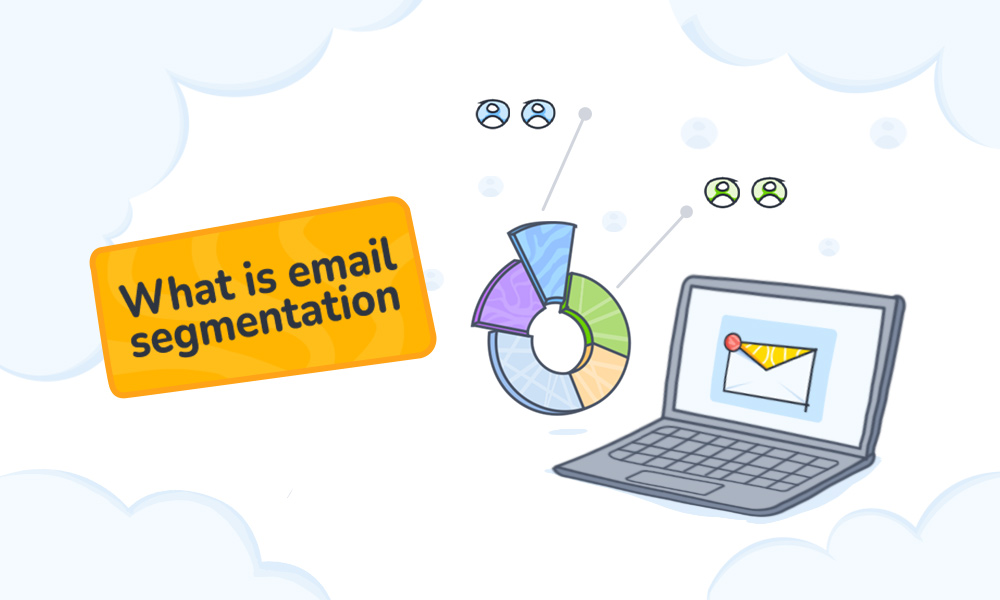
 Contents
Contents